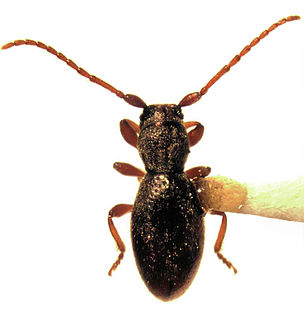
The insects of the beetle family Chrysomelidae are commonly known as leaf beetles, and include over 37,000 species in more than 2,500 genera, making up one of the largest and most commonly encountered of all beetle families. Numerous subfamilies are recognized, but the precise taxonomy and systematics are likely to change with ongoing research.

The longhorn beetles are a large family of beetles, with over 26,000 species described, slightly more than half from the Eastern Hemisphere. Most species are characterized by extremely long antennae, which are often as long as or longer than the beetle's body. In various members of the family, however, the antennae are quite short and such species can be difficult to distinguish from related beetle families such as the Chrysomelidae. The scientific name of this beetle family goes back to a figure from Greek mythology: after an argument with nymphs, the shepherd Cerambus was transformed into a large beetle with horns.

A woodworm is the wood-eating larva of many species of beetle. It is also a generic description given to the infestation of a wooden item by these larvae.

Polyphaga is the largest and most diverse suborder of beetles. It comprises 144 families in 16 superfamilies, and displays an enormous variety of specialization and adaptation, with over 350,000 described species, or approximately 90% of the beetle species so far discovered.

The term woodboring beetle encompasses many species and families of beetles whose larval or adult forms eat and destroy wood. In the woodworking industry, larval stages of some are sometimes referred to as woodworms. The three most speciose families of woodboring beetles are longhorn beetles, bark beetles and weevils, and metallic flat-headed borers.

Cactus longhorn beetles are large, flightless, black beetles found in North American deserts of the western United States and northern Mexico. M. gigas is native to the Sonoran desert at elevations below 4900 feet (1500m). The front wings of these beetles are fused forming a single, hardened shell, from which the genus derives its Latin name. The genus includes twenty species.

Rhagonycha is a genus of soldier beetle belonging to the family Cantharidae. There are at least 140 described species recorded from Europe, North America and Japan, and thought to date from the Upper Eocene to recent periods.

The valley elderberry longhorn beetle,, is a subspecies of longhorn beetle native to the riparian forests of the Central Valley of California from Redding to Bakersfield. It is listed as a federally threatened species; a proposal to delist the insect was withdrawn in 2014.

Xylotoles costatus, the Pitt Island longhorn beetle, is a species of beetle in the family Cerambycidae. It is endemic to the Chatham Islands. Once thought to be extinct, it is now known to survive on South East Island/Rangatira; being therefore an example of a so-called "Lazarus taxon".

Stenotrachelidae, commonly called false longhorn beetles is a family of beetles, in the large suborder Polyphaga.

Anaesthetis is a genus of longhorn beetles belonging to the subfamily Lamiinae.
Anthony Adrian Allen was a British entomologist who published several hundred scientific papers, in particular on the Coleoptera (beetles) of the British Isles. He was active for much of the middle and late 20th century. He formed a bridge between the great entomologists of last century, and the present generation, many of whom benefitted from his knowledge and guidance.

Tetropium fuscum, the brown spruce longhorn beetle, is a species of beetle in the family Cerambycidae. It was described by Johan Christian Fabricius in 1787. Tetropium fuscum is native to Europe and Northern Asia, and has been introduced to Nova Scotia, Canada. Brown spruce longhorn is a pest of spruce trees.

Cyclocephala is a genus of scarab beetles from the subfamily Dynastinae. Beetles of this genus occur from southeastern Canada to Argentina and the West Indies.
Nebria testacea is a species of ground beetle in the Nebriinae subfamily that can be found in Greece and Turkey. It is also common on various European islands, such as Crete, Cyclades, and Dodecanese.
Cerdaia testacea is a species of longhorn beetle in the Cerambycinae subfamily. It was described by Cerda in 1980. It is known from Chile.
Egalicia is a genus of longhorn beetles of the subfamily Lamiinae, containing the following species:

Somatidia is a genus of longhorn beetles of the subfamily Lamiinae, containing the following species:
Linda is a genus of longhorn beetles of the subfamily Lamiinae, containing the following species:
Monotoma testacea is a species of root-eating beetle in the family Monotomidae. It is found in Australia, Europe & Northern Asia, and North America.














